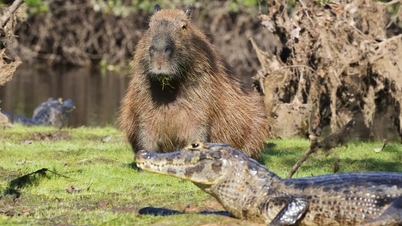How many species of capybara are there?
According to the Natural History Museum, the capybara is a mammal of the order Rodentia, genus Hydrochoerus - which means "water pig" in Greek.
Capybaras are divided into two species: the large capybara and the small capybara.
The giant capybara is the world's largest rodent, measuring about 1.3m long and weighing between 30-70kg.
They are widely distributed throughout South America, living in places with abundant water sources such as wetlands, swamps and grasslands.
The smaller capybara is more modest in size, weighing a maximum of about 28kg and measuring about 1m in length, and prefers shady forests and wetlands, found mainly in northern South America and southern Panama.

The small capybara has the scientific name Hydrochoerus isthmius (Photo: iNaturalist).
Large capybaras have stocky bodies and coarse, straw-like fur, while small capybaras have a more streamlined appearance and softer, darker fur.
What do capybaras eat?
Capybaras primarily eat plants, especially tough, fibrous grasses. These are difficult to digest, making them susceptible to malnutrition.
To compensate, capybaras often re-eat their own feces, a behavior known as coprophagy .
This allows them to absorb additional important nutrients that were missed during the first digestion.
Their chisel-like incisors grow continuously, forcing the rodents to wear them down regularly by chewing on tree bark, tough grasses, or aquatic plants.
Capybara Lifestyle
In the wild, capybaras live in herds of 10-20 individuals. When the dry season comes, limited water resources cause herds to merge, which can reach up to 30 individuals.

Living in groups is important for the survival of capybaras (Photo: Shutterstock).
A female usually gives birth to 2-8 pups, and capybara pups develop very quickly, and can begin grazing shortly after birth.
For the first three months, baby capybaras nurse from their mother and from other females in the group, a common form of social rearing in this species.
At birth, baby capybaras are vulnerable to predators and typically remain in the herd until about a year old.
They are targeted by caiman crocodiles, harpy eagles, anacondas, and ocelots.
To protect the herd, adult capybaras always maintain vigilance. When they detect danger, they emit a characteristic bark to alert the herd to retreat to the water.
Adult capybaras are less at risk, with jaguars being their most formidable natural predators.
In some areas, capybaras are hunted by humans for their meat and skin.
What makes capybaras such good swimmers?
Capybaras are semi-aquatic animals and are excellent swimmers thanks to their semi-webbed feet and can hold their breath for up to 5 minutes underwater, helping them escape predators.
Even baby capybaras can swim, following their mothers into the water within minutes of birth.

With eyes, nostrils and ears located on top of their heads, capybaras can live underwater (Shutterstock).
The eyes, ears and nose are located high on the head, allowing the capybara to be almost completely submerged in water while still being able to see, hear and breathe.
Why do capybaras ride on the backs of animals?
According to some researchers, capybaras sometimes climb onto the backs of crocodiles to reduce the risk of being attacked when crossing water.
Alligators do not usually attack other alligators just to compete for a capybara lying on the other's back.
This unique "hitchhiking" behavior makes it safer for capybaras to pass through areas with many underwater predators, although this is not a behavior that occurs frequently in the wild.
According to Capybara Nation, it's also possible that capybaras ride on crocodiles simply because they want to.
With their curious nature, capybaras may choose to ride on the backs of large reptiles for entertainment and to gain a new perspective when crossing water.

Capybara lets another animal stand on its back (Shutterstock).
Notably, capybaras allow many other animals to climb on their backs, forming a symbiotic relationship rarely seen in nature.
Source: https://dantri.com.vn/khoa-hoc/kham-pha-nhung-dieu-thu-vi-it-ai-biet-ve-chuot-lang-nuoc-20251125001257837.htm












































































































Comment (0)